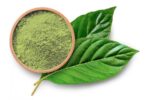Molecules 2009, 14, 3964-3974; doi:10.3390/molecules14103964
Article
Evaluation of Antioxidant and Antibacterial Activities of
Aqueous, Methanolic and Alkaloid Extracts from Mitragyna
Speciosa (Rubiaceae Family) Leaves
Suhanya Parthasarathy 1
, Juzaili Bin Azizi 1
, Surash Ramanathan 1
, Sabariah Ismail 1
,
Sreenivasan Sasidharan 2,*, Mohd Ikram Mohd. Said 3
and Sharif Mahsufi Mansor 1
1 Centre for Drug Research, Universiti Sains Malaysia, 11800 Minden, Penang, Malaysia
2 Institute for Research in Molecular Medicine, Universiti Sains Malaysia, 11800 USM, Pulau
Penang, Malaysia
3 School of Chemical Sciences and Food Technology Universiti Kebangsaan Malaysia 43600 Bangi,
Selangor, Malaysia
* Author to whom correspondence should be addressed; E-Mail: srisasidharan@yahoo.com.
Received: 23 July 2009; in revised form: 21 August 2009 / Accepted: 15 September 2009 /
Published: 9 October 2009
Abstract: Studies on the antioxidant and antimicrobial activities of Mitragyna speciosa
leaf extracts are lacking. In this study the antioxidant properties of water, methanolic and alkaloid M. speciosa leaf extracts were evaluated using the DPPH (2,2-diphenyl-1-
picrylhydrazyl) radical scavenging method. The amount of total phenolics and flavanoid
contents were also estimated. The DPPH IC50 values of the aqueous, alkaloid and
methanolic extracts were 213.4, 104.81 and 37.08 μg/mL, respectively. The total phenolic
content of the aqueous, alkaloid and methanolic extracts were 66.0 mg, 88.4, 105.6 mg
GAE/g, respectively, while the total flavanoid were 28.2, 20.0 and 91.1 mg CAE/g
respectively. The antioxidant activities were correlated with the total phenolic content.
This result suggests that the relatively high antioxidant activity of the methanolic extract
compared to aqueous and alkaloid extract could be possibly be due to its high phenolic
content. The aqueous, alkaloid and methanolic extracts were screened for antimicrobial
activity. The extracts showed antimicrobial activity against Salmonella typhi and Bacillus
subtilis. The minimum inhibitory concentrations (MICs) of extracts determined by the
broth dilution method ranged from 3.12 to 6.25 mg/mL. The alkaloid extract was found to
be most effective against all of the tested organisms.
1. Introduction
Natural products, such as plant extract, either as pure compounds or as standardized extracts,
provide unlimited opportunities for new drug discoveries because of the unmatched chemical diversity
the can provide [1]. According to the World Health Organization (WHO), more than 80% of the
world’s population relies on traditional medicine for their primary healthcare needs. This has captured
the interest of many researchers to explore local medicinal plants for valuable medicinal traits. Several
studies indicate that medicinal plants contain compounds like peptides, unsaturated long chain fatty
acids, aldehydes, alkaloids, essential oils, phenols and water or ethanol soluble compounds. These
compounds are significant in therapeutic application against human and animal pathogens, including
bacteria, fungi and viruses [2,3]. In recent years, numerous drug resistances in human pathogenic
microorganisms have developed due to the indiscriminate use of commercial antimicrobial drugs
commonly used in the treatment of infectious diseases. On the other hand, free radicals are known to
be the major cause of various chronic and degenerative diseases. Oxidation is a natural process in
organisms for the production of energy to fuel biological cycles. Conversely, the uninhibited
production of oxygen-derived free radicals is involved in the onset of many diseases such as arthritis,
atherosclerosis, rheumatoid and cancer as well as in many degenerative diseases related with aging [4].
This situation has prompted the continuous search for various plant sources with these medicinal
values. Mitragyna speciosa is a tropical plant indigenous to the Northern Malay Peninsula and
Thailand. The leaves of this plant are, known as “Biak” and “Ketum” in Malaysia, and as “Kratom” in
Thailand. Mitragynine has been suggested as a useful constituent in the treatment of opiate addiction
as a replacement therapy [5]. The leaves has been also reported for its, antitussive, anaesthetic
,antinociceptive, stimulant, analgesic and narcotic-like actions properties [5-7]. However, to date no
research on antimicrobial and antioxidant properties of the M. speciosa have been documented. In this
study we report the antimicrobial and antioxidant activities of aqueous, methanolic and alkaloids
extracts of M. speciosa leaf.
2. Results and Discussion
Existing literature mainly reports the antitussive, anaesthetic, antinociceptive, stimulant, analgesic
and narcotic-like action pharmacological activities of M. speciosa leaves. These pharmacological
activities are often attributed to the alkaloids found in the leaf [6]. Mitragynine is the dominant
alkaloid and is exclusive to M. speciosa. To date, studies on the antioxidant and antimicrobial
properties are limited and not thoroughly documented. In this study the methanolic, alkaloid and
aqueous extracts of the plant leaves were evaluated for their antioxidant and antimicrobial properties.
2.1. Total phenolic and flavanoid content
Table 1 shows the total phenolic and flavanoid contents in the Mitragyna speciosa leaf extracts. The
highest (P < 0.05) amount of phenolic content was found in the MeOH extract (105.58 ± 15.43 mg/g)



